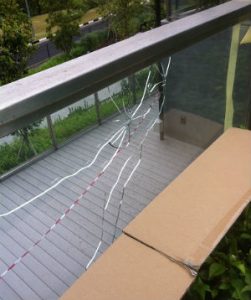Table of Contents
1. Introduction
The phenomenon of sudden cracking or breaking of toughened glass (tempered glass) without any transparent reason is called spontaneous glass breakage.
This problem is usually seen in areas having hot climatic conditions.

Some of the countries that are facing the spontaneous glass breakage problem to a high extent are the USA, UAE, India, Saudi Arabia, Qatar, China, Pakistan, etc.
2. Causes of Spontaneous Glass Breakage
Some of the causes of spontaneous glass breakage are:
a. Thermal Stress
The stress caused by the alternating temperature is thermal stress. During the hot climate, glass expands, and during the cold climate, glass contracts. This alternate expanding and contracting causes sudden breakage of glass without apparent reason.
The breakage of large rocks in nature is also the result of thermal stress. So, breaking thick and tough glass due to thermal stress is not a unique incident.
In deserty regions; the temperature at day time is very high ( Up to56.7º C) and the temperature at night time is very low ( up to – 4° C ). This alternate temperature increases thermal stress on the glass and causes spontaneous glass breakage.
Insulating glasses have to face more thermal stress as compared to other glasses. They have to manage the temperature inside the building.
So, they absorb and reflect the light from the external side and the temperature of the external side is high but the internal side remains cool. This variable temperature on the same material leads to an increase in thermal pressure causing sudden cracking and breaking of glass.
b. Improper Framing Of Glass
Very tight framing of glass is another main cause of sudden cracking and breaking of glass.
During hot temperatures; glass expands. When the frame of the glass is very tight, the expansion of the glass is prevented by the frame.
This increases the pressure on the glass and causes spontaneous breakage of the glass.
c. Internal Defects
Complete elimination of contaminants during the manufacture of glass is not possible.
Such contamination leads to internal defects.
The inclusion of nickel sulphide in the glass is the main cause of the internal defects of glass.
d. Insufficient Glass Thickness
If the thickness of the glass is insufficient to resist the load that is given by the wind; then it causes spontaneous glass breakage.
e. Improper Edging
Improper edging and finishing of the glass during the cutting process is another main cause. Mostly, the glass starts breaking or cracking from improper edges.
f. Age of Glass
Overtime; the thickness of the glass at the bottom slightly increases and the thickness at the top slightly decreases. This is the effect of the flow of glass molecules from top to bottom due to gravity. It also causes spontaneous glass breakage.
3. Effects of Spontaneous Glass Breakage
The main effects of spontaneous glass breakage are:
a. Sudden breakage of glass in high-rise buildings may lead to big and serious accidents.
b. Financial Loss
4. Prevention of Spontaneous Glass Breakage
The preventive measures for spontaneous glass breakage are:
a. Proper edging of glass edges during the cutting process.
b. Using thick glasses in windy areas.
c. Proper framing concerning the expansion of glass.
d. Using small glass panels in place of large panels. This increases the durability of the glass.
For example, We need a 5′ * 3′ glass panel for our balcony parapet. Using two panels of 2.5′ * 3′ is good rather than one 5′ * 3′ panel.
| Read More: Surkhi |
| Read More: Plinth Area |

